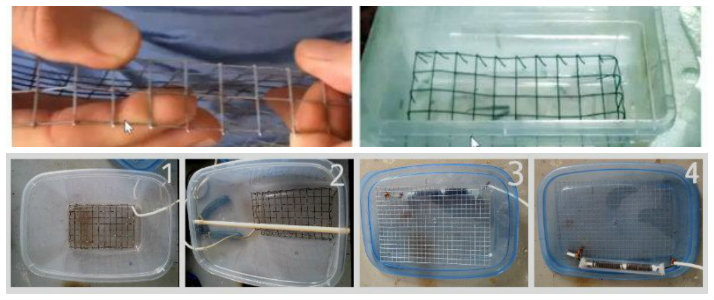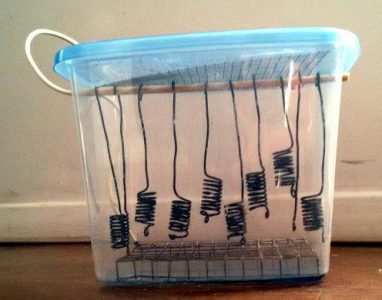Preparations for the Nano Coating Process
Can all materials be coated?
In principle ‘yes’, but all natural materials such as wood, plant leaves, roots, etc. are already in a GaNS state – so there is no need to coat them. The nano coating of other materials, such as plastic, glass etc. is done by a caustic solution. These techniques will be shown in an advanced course.
General Instructions
- Always wear gloves and avoid touching parts that go through the nano coating process as much as possible. Nano particles are so small that they easily pass through the skin to enter your body.
- Do not move objects during nano coating. Nano layers are super fragile and can easily be damaged by touching them. It is advisable to assemble the pieces to be nano plated as much as possible before coating them.
Prepare the container for nano plating

You need a suitable plastic container with a lid and galvanized steel mesh (chicken or rabbit wire)
- Cut a square of the mesh a little larger than the bottom of the container
- Fold the 4 sides of the mesh so that the surface for depositing the objects is 1-2 cm higher than the bottom; this prevents the objects from soaking in the caustic liquid.
- Attach a copper wire (multi-strand) to it and run it outside the container through a hole at the top of the container. Place the grid at the bottom of the container.
- Attach a grid to the inside of the cover and attach a multi-strand copper wire to it; run the wire out through a hole near the edge of the cover.
- Attach a plasma capacitor to the outside of the cover. Connect one wire to each capacitor terminal; it does not matter which wire is attached to which capacitor terminal.
The capacitor transfers its plasma energy to both grids and thus creates a plasma field between the two grids. This polarizes the objects to be plated and there is no need to drain them at the end of the nano coating.
- Drill two holes opposite each other to pass a round wooden rod through; it serves to hang the objects to be coated.
Other ways to place objects
1. You can either hang the objects on a rod or place them on a grid.
2. Plates can be placed in a dish dryer grid: for this purpose, cut off the part of the dryer that normally holds the plates, which you place in the box (3).
